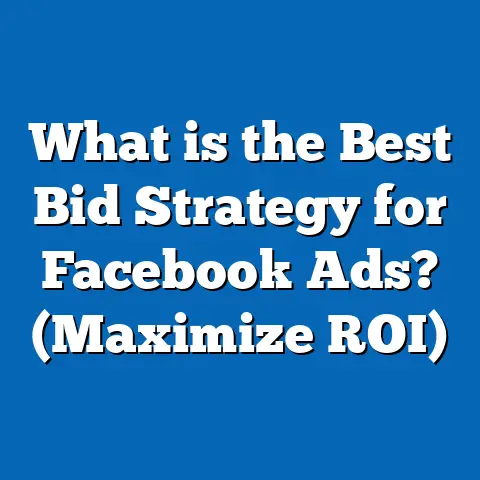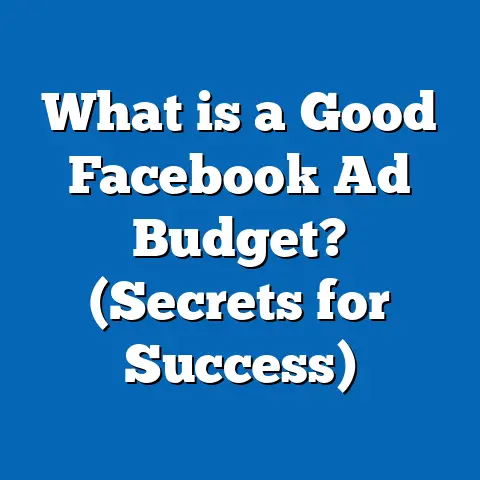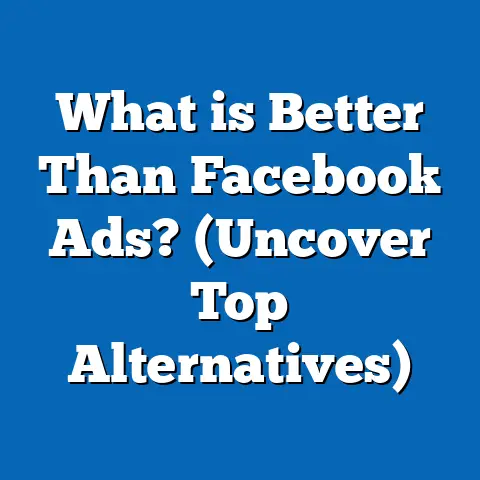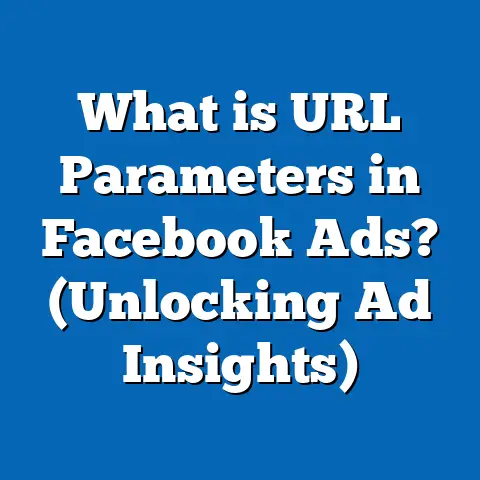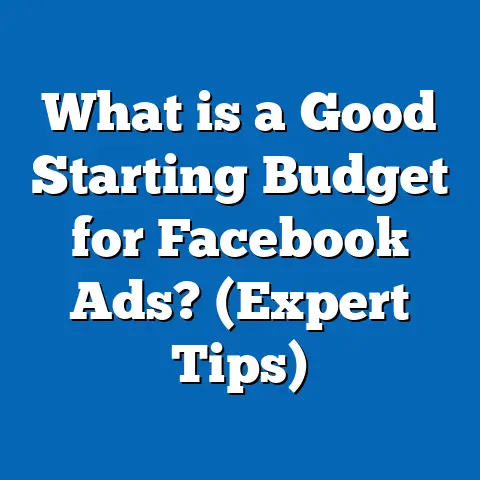What is a Video Lead Ad on Facebook? (Unlocking Engagement)
Introduction: The Comfort of Connection
In the digital age, comfort is more than a feeling—it’s an expectation. Audiences want to interact with brands in ways that feel familiar, seamless, and engaging. For business owners and marketers, the challenge is clear: How do you create ads that not only capture attention but also invite genuine, comfortable interaction? Video Lead Ads on Facebook offer a solution that merges the comfort of video storytelling with frictionless data collection, unlocking new levels of engagement and conversion.
Understanding Facebook Lead Ads: A Foundation
What Are Facebook Lead Ads?
Facebook Lead Ads are a specialized ad format designed to gather information from users directly within the Facebook or Instagram platform. Unlike traditional ads that redirect users to external landing pages, lead ads present a seamless, in-app form, reducing friction and dropout rates.
- Lead Form Integration: Forms are pre-filled with user data such as name and email.
- Privacy Controls: Users can review and edit their info before submitting.
- Instant Experience: The entire process happens without leaving Facebook or Instagram.
Why Do Lead Ads Matter?
According to Meta’s internal data, lead ads reduce the cost per lead by up to 60% compared to traditional landing page forms. The streamlined experience means higher completion rates, with average conversion rates for lead ads ranging from 10-25%, depending on industry and targeting.
Introducing Video Lead Ads: Marrying Visual Storytelling with Conversion
What is a Video Lead Ad on Facebook?
A Video Lead Ad combines the engaging power of video with the efficiency of Facebook’s lead generation forms. Instead of using a static image, advertisers use a video as the creative asset. When viewers interact with the video (by clicking or tapping), they’re prompted to complete a lead form—without ever leaving the Facebook environment.
Why Video?
- Attention Retention: Users spend 5x longer watching video content vs. static images (Facebook IQ).
- Message Delivery: Videos convey complex messages quickly; 95% of viewers retain a message when watched via video compared to 10% when reading text (Insivia).
- Emotional Impact: Videos evoke emotion, increasing trust and recall.
How Do Video Lead Ads Work?
- User Scrolls Feed: Sees a video ad.
- Engagement Trigger: User taps Learn More/Sign Up.
- Instant Form Pops Up: Pre-filled with user info.
- Submission: User reviews and submits details in seconds.
The Psychology Behind Video Engagement
Why Are Videos So Effective for Lead Generation?
- Visual Storytelling: Human brains process visuals 60,000x faster than text.
- Trust Building: Videos showcase authenticity; seeing a founder or team member fosters credibility.
- Micro-Moments: 76% of users prefer short videos for quick information (Wyzowl).
Comfort and Familiarity
Video content feels less intrusive and more conversational. Research by HubSpot shows 54% of consumers want to see more video content from brands they support, making video not just effective—but expected.
Data-Backed Performance Insights
Conversion Rates and Costs
- Lead Ads vs. Landing Pages: Average cost per lead drops by 20-60% with native lead forms (Meta).
- Video vs. Static Lead Ads: Video Lead Ads have shown up to 30% higher click-through rates (CTR) and 2x greater form completion compared to static images (WordStream).
- Mobile Optimization: 98% of Facebook’s daily active users access via mobile (Meta Q4 2023), making instant, mobile-friendly forms critical.
User Behavior Patterns
- Time Spent: The average user spends 34 minutes per day on Facebook; video content receives 135% greater organic reach than photo posts (Socialbakers).
- Engagement Windows: Most leads are captured within the first 24 hours of campaign launch due to platform prioritization of new content.
Technical Anatomy of a Facebook Video Lead Ad
Components Explained
- Video Asset
- Recommended length: 15-30 seconds.
- Optimal dimensions: 1080×1080 (square) or 9:16 (vertical).
- Captions/subtitles: Increases completion rate by up to 12%.
- Ad Copy
- Clear headline (40 characters max).
- Direct call-to-action (e.g., “Get Your Free Guide”).
- Instant Form
- Pre-filled fields: Name, email, phone.
- Custom questions: Qualify leads further.
- Privacy policy link: Required by Facebook.
- Thank You Screen
- Confirmation message.
- Optional CTA: “Visit our website” or “Call now.”
Customization Options
- Multi-step forms for deeper qualification
- Conditional logic for personalized questions
- Automated CRM integration via Zapier or API
Setting Up Your First Video Lead Ad
Step-by-Step Guide
Step 1: Define Your Objective
Choose “Lead Generation” as your campaign objective in Facebook Ads Manager.
Step 2: Create Your Audience
Use custom audiences based on website visitors, page engagement, or lookalikes for higher relevance.
Step 3: Craft Your Video Asset
Tips:
- Keep it short and focused.
- Showcase your offer visually.
- Include branding in the first seconds.
- Add captions for silent autoplay viewers.
Step 4: Build Your Instant Form
- Select essential fields only.
- Use qualifying questions sparingly to avoid drop-offs.
- Link your privacy policy.
Step 5: Optimize Thank You Screen
Provide next steps (“Download Now,” “Call Us,” etc.) to keep leads engaged post-submission.
Step 6: Launch & Monitor
Monitor performance within Ads Manager—focus on metrics like CPL (Cost Per Lead), form completion rate, and video engagement (3-second views, average watch time).
Advanced Strategies for Video Lead Ads
Leveraging Retargeting
Retarget users who watched at least 50% of your video but didn’t submit the form. This segment is highly engaged and more likely to convert with a follow-up offer.
Dynamic Creative Testing
Test multiple video variations. According to Facebook internal studies, dynamic creative optimization can increase conversion rates by up to 15%.
Integrating Chatbots
Connect your lead form submissions to Messenger bots for instant follow-up—improving response time and nurturing leads automatically.
Practical Examples and Case Studies
Case Study 1: B2B SaaS Company
Objective: Generate demo requests
Approach: Used a 20-second explainer video showing product benefits
Results:
- 42% decrease in cost per lead vs. static image lead ads
- 28% higher lead quality as measured by sales-qualified leads
- CTR increased by 37%
Case Study 2: Local Gym Chain
Objective: Drive free trial sign-ups
Approach: Ran a series of short testimonial videos featuring clients
Results:
- Cost per lead reduced from $13.75 to $7.10
- Video completion rate at 62%
- Over 60% of leads attended first free session
Case Study 3: Online Education Provider
Objective: Capture interest in new course launches
Approach: Used animated videos highlighting course content and outcomes
Results:
- 5x increase in lead volume compared to previous campaigns
- CPL dropped by 49%
- Email open rates from these leads averaged 44%
Comparison: Video Lead Ads vs. Other Platforms and Formats
| Feature | Facebook Video Lead Ad | LinkedIn Lead Gen Form | Google Lead Form Extension |
|---|---|---|---|
| In-platform Submission | Yes | Yes | Yes |
| Video as Creative | Yes | No | No |
| Pre-filled User Data | Yes | Yes | Some |
| Mobile-first Design | Yes | Yes | Yes |
| CRM Integration | Yes | Yes | Limited |
| Audience Targeting Depth | High | High | Moderate |
Key Insights:
Facebook’s unique advantage is the ability to combine powerful video storytelling with instant, mobile-friendly lead capture—backed by robust targeting options.
Common Mistakes and How to Avoid Them
Over-complicating the Form
Asking too many questions increases abandonment rates. Keep it simple—request only what’s essential.
Weak Video Content
Low-quality or unclear videos reduce engagement. Invest in production value and clear messaging.
Ignoring Follow-up
Leads decay fast; over half lose interest if not contacted within an hour (InsideSales.com). Automate follow-ups where possible.
Measuring Success: Key Metrics to Track
- Cost Per Lead (CPL)
- Form Completion Rate
- Video Engagement (3-second views, average watch time)
- Lead Quality (Sales-qualified leads vs. marketing-qualified)
- Follow-up Rate (How quickly leads are contacted)
Use split testing to refine targeting, creative, and form fields continuously.
Industry Trends and Future Outlook
Interactive Video Forms
Meta is testing interactive elements within videos—think polls or mini-quizzes before showing the lead form—to drive even higher engagement.
AI-Powered Targeting
AI-driven audience segmentation is improving match rates, increasing relevance, and reducing wasted ad spend.
Deeper CRM Integrations
New tools allow real-time syncing of leads directly into sales pipelines, reducing manual work and speeding up response times.
Next Steps: Implementing Video Lead Ads for Your Brand
- Audit Your Funnel: Where could a seamless, video-based lead gen process reduce friction?
- Develop Engaging Video Content: Focus on clarity, brevity, and direct value.
- Test Multiple Variations: Use A/B testing for creative, audience, and forms.
- Automate Lead Follow-Up: Integrate with CRM or chatbot solutions.
- Analyze & Iterate: Use data-driven insights to refine campaigns over time.
Key Takeaways
- Video Lead Ads on Facebook merge the comfort of visual storytelling with frictionless data collection.
- They consistently outperform static lead ads in both cost-efficiency and engagement.
- Success relies on clear, compelling video content and keeping forms simple.
- Rapid follow-up is critical—automation is your friend.
- Stay updated on new features like interactive video forms and AI-powered audience tools for continued success.
By harnessing the unique strengths of Video Lead Ads on Facebook, marketers and business owners can unlock higher engagement, better leads, and ultimately greater ROI—all while providing a comfortable experience for their audience.
For further reading, explore Meta’s official guide and case studies from WordStream.

